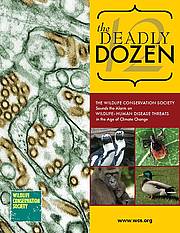Forewarned is forearmed
07 October 2008 | News story
Health experts from the Wildlife Conservation Society (WCS) released a report that lists 12 pathogens that could spread into new regions as a result of climate change, at the IUCN World Conservation Congress today. All have potential impacts to human and wildlife health, as well as global economies.
The new report The Deadly Dozen: Wildlife Diseases in the Age of Climate Change provides examples of diseases that could spread as a result of changes in temperature and rainfall. The best defence, according to the report’s authors, is a good offence in the form of wildlife monitoring to detect how these diseases are moving. Health professionals can then start to prepare.
“The monitoring of wildlife health provides us with a sensitive and quantitative means of detecting changes in the environment,” said Dr. William Karesh, Vice President and Director of WCS’s Global Health Programs and Co-Chair of IUCN’s Wildlife Health Specialist Group. “Wildlife health monitoring provides a new lens to see what is changing around us and will help governments, agencies, and communities detect and mitigate threats before they become disasters.”
“The term ‘climate change’ conjures images of melting ice caps and rising sea levels that threaten coastal cities and nations, but just as important is how increasing temperatures and fluctuating precipitation levels will change the distribution of dangerous pathogens,” said Dr. Steven E. Sanderson, WCS President and CEO.
“The health of wild animals is tightly linked to the ecosystems in which they live and influenced by the environment surrounding them, and even minor disturbances can have far-reaching consequences on what diseases they might encounter and transmit as climate changes. Monitoring wildlife health will help us predict where those trouble spots will occur and plan how to prepare.”
The “Deadly Dozen” – including such diseases as avian influenza, Ebola, cholera, and tuberculosis – is illustrative only of the broad range of infectious diseases that threaten humans and animals.
As well as the health threats that diseases pose to human and wildlife populations, the pathogens that originate from or move through wildlife populations have already destabilized trade to a large extent and caused significant economic damage. For instance, avian influenza and several other livestock diseases that have reemerged since the mid-1990s have caused an estimated $100 billion in losses to the global economy.
WCS’s Global Health Programs currently lead an international consortium that helps to monitor the movements of avian influenza through wild bird populations around the world. The GAINS program (Global Avian Influenza Network for Surveillance) was created in 2006 with support from the United States Agency for International Development (USAID) and now involves dozens of private and public partners that monitor wild bird populations for avian influenza around the world.
“Emerging infectious diseases are a major threat to the health and economic stability of the world,” said Congresswoman Rosa L. DeLauro a champion for the GAINS Program. “What we’ve learned from WCS and the GAINS Program is that monitoring wildlife populations for potential health threats is essential in our preparedness and prevention strategy and expanding monitoring beyond bird flu to other deadly diseases must be our immediate next step.”







